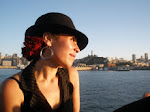
In Cerca de la Cerca, the border fence that divides Mexico and the United States is at the center. Maria Teresa Fernandez, a Mexican photographer now living in San Diego, photographed the fence over. Through her work, the function of the fence in people's lives becomes clear: its a obstacle to overcome to those for whom the American Dream pulls at; an ever more fortified barrier to stanch the flow of people coming in; a divider of people.
At UCSC, Cerca de la Cerca exhibition covers the walls of two rooms. Fernandez has been careful to capture all aspects of the fence, and organized the exhibition accordingly.
The first groupings of untitled photographs capture the fence alone: first as a long corroded metal fence that extends into the Pacific ocean, a close up of the corrosion of the fence and through a hole in it, a landscape of San Diego to the other side, and then a series of images in which it is unclear from which side we look over or through or at the fence from, but in each, the texture and colors of metal striping away are tangible.
With the introduction of heightened surveillance to reduce border crossings with Operation Gatekeeper in 1994, migrants have been forced to cross the border through the harsh desert to the east and many more people die in their attempt. In response, along the Mexican side of the border fence, alters crop up like nightmarish blooms. The alters are made in the tradition of Dia de los Muertos alters, yet these are replenished year round. They yearn for the missing and gone, or list the dead found and never identified, they commemorate those who have died and seem to beg the fence itself for relief. In these alters, the struggle, the tragedy, the hope and desperation and powerlessness literally hang off the fence in alters colored like celebration. These photographs explode with brilliant colors and are full of roses, marigolds, giant tissue paper flowers and wreaths.
Murals intersperse the alters along the southern side of the border fence. This art encourages people across, with statements like, "Bienvenidos al sueno americana" or painted silhouettes of men climbing over, even while others make a clear statement to the death threat the new wall is to those who would cross over. Painted blood seeps across a landscape in one mural; in another, Death stands at a gate between the US and Mexico.
It appears that people live right up alongside the border fence in Mexico: it is a barrier to turn into a weeping wall, a protest wall, a wall to hang your hopes and anger and desperation on, yes, but Fernandez has also presented images of trash blown up in piles along the wall and towns that abruptly stop in the presence of the wall. The collection of images from the Mexican side of the border reveal a vitality that is hemmed in only physically by the fence.
In contrast, the images of the U.S. side of the border fence are spare. Urban development can be seen in the distance, but they stop well north of the fence. The hilly, arid terrain stops shy of the second barrier fence by a dirt road that runs along the fence. In one photograph, the double fence, outfitted with spotlights and lookout towers, seem to race along the curving landscape.
After establishing the lay of the land, Fernandez introduces the people that live on and near the border and reveals the delicate nature of the relationships that often straddle the border. Before Friendship Park (in San Diego, a point where people could visit across the border fence) was closed down, Fernandez photographed a series of meetings. In one, family and friends picnic, but they sit separated by the fence, and talk through slats. In another, a father and daughter visit their family, who are obscured by the fence. People kiss, children are lifted through, adults reach their hands through to touch the people on the other side. In this series, the sacrifices that people make to cross the border reveal the intensity of the desire to try and make a better life.
Against this, Fernandez posits the U.S. Military personnel patrolling the border. The men are completely outfited with goggles, helmets vests and guns as they work to shore up the permeability of the fence. At work, these men give U.S. policy an unforgiving and inflexible face, especially when the next grouping of images are of people climbing over the fence. One man uses and alter as a ladder and carries little else but the ragged shirt and pants he wears. He is no threat to the Border Patrol.
With Cerca de la Cerca, Fernandez highlights the permeability and mortality of the fence by focusing on the corroded holes and barnacles growing on it and then mirroring this disintegration in the photographs of Mexican murals depicting men tearing down the fence. She creates compassion and humanity on the Mexican side of the fence, while making out the US side to be desolate, a effect heightened by the brilliant colors of the fence art against the drab military colors of both the uniforms and land of the US.


No comments:
Post a Comment